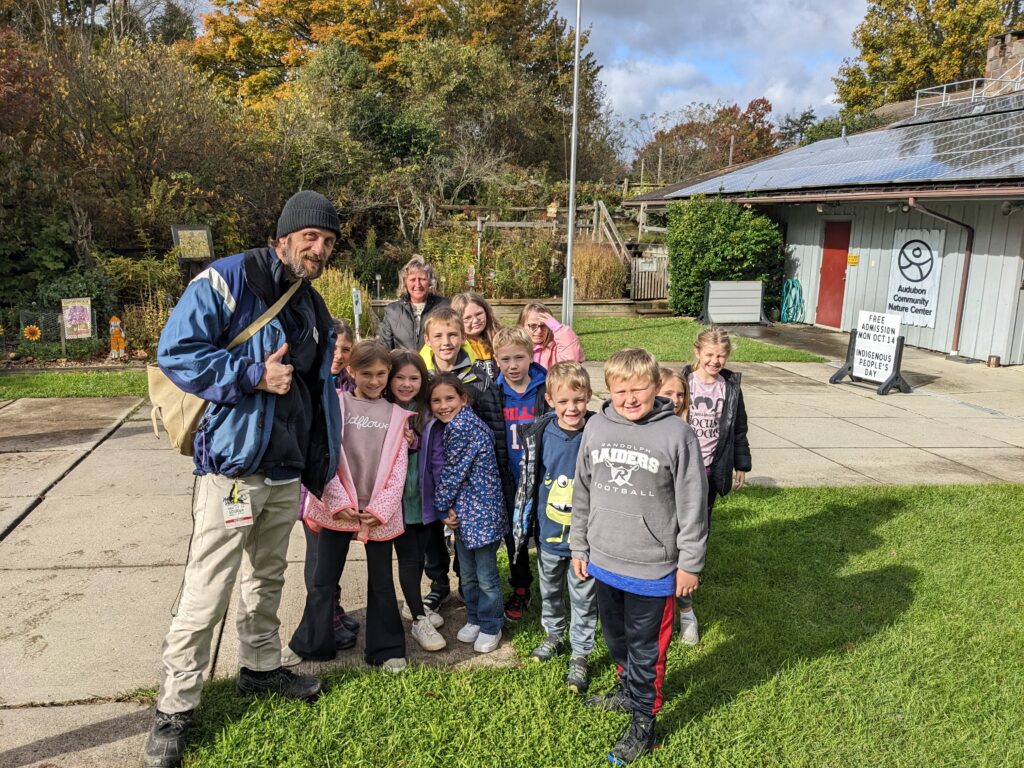by Mac Dawson, Nature Educator
As a Nature Educator, I tour our area’s schools doing my best to connect our kids to the natural world with bear skins, raccoon puppets, and games. I do my best to be mindful of my methods and habits so as to continually refine my craft. Every day, I change something in my practice that makes it more effective as a means of inspiring curiosity. Though my process is continually adapting, there are tools of the trade I consider essential; adaptability, patience, structure, and creativity are necessities for sure, but above all of these I consider empathy to be the most vital. Empathy allows me to make the initial connection that makes my students feel safe, validated, and engaged. It allows me to understand and respond to their perspectives, feelings, and needs. But working specifically as a Nature Educator, I’ve found that when I effectively connect my students to the interconnectedness of the natural world, they naturally conclude that they too have a role, impact, and responsibility to their environments.
In this profession, I’m coming to understand that learning can foster empathy for the environment. It enhances intellectual growth by combining emotional awareness with critical thinking. It strengthens reasoning and problem-solving, fostering open-mindedness. By promoting a blend of intellect and compassion, empathy encourages thoughtful, responsible decision-making.

When we bridge the gap between abstract ecological concepts and personal connection, we can understand ecosystems and their intricate relationships between species, showing how each contributes to environmental balance. This knowledge makes for a sense of empathy by helping learners see nature as a community they belong to, rather than a set of resources to exploit. This perspective fosters a moral responsibility to care for the land and its inhabitants as partners in the web of life. Stewardship thus becomes empathy in action, driven by a desire to preserve the health and beauty of the natural world.
Environmental stewardship requires empathy not only for those living today but also for future generations. The concept of intergenerational empathy then challenges us to consider how our actions shape the future. By empathizing with future generations, we understand the importance of sustainable practices.
In her book “Silent Spring”, Rachel Carson helped launch the modern environmental movement by observing that “Those who contemplate the beauty of the earth find reserves of strength that will endure as long as life lasts.” In other words, spending time in nature and reflecting on its beauty can evoke awe and respect, creating a powerful emotional connection that motivates people to protect the environment—not just for themselves but for the planet and future generations.
Fostering compassion is essential for creating a sustainable and caring society. Social inequality and environmental degradation are deeply intertwined challenges in today’s world. By understanding our connection to both other people and the natural world, we are inspired to take responsible action. Truly prioritizing the well-being of society means extending our consideration to the ecosystems that support us. At its core, empathy urges us to recognize the interconnectedness of all life, motivating us to protect and nurture our shared home.
If we want a sustainable future, we must cultivate environmental empathy. Viewing ourselves as part of nature helps us develop the compassion and understanding needed to be true stewards of the earth. Recognizing how deeply our lives intertwine with other creatures and ecosystems leads us to consider the environmental impact of our actions. Then we might become more inclined to act as responsible stewards of the earth, driven by a desire to protect the beauty, complexity, and interconnectedness that sustain life. In this way, environmental stewardship becomes both a duty and a testament to our shared humanity and responsibility toward our shared planet.
Audubon Community Nature Center builds and nurtures connections between people and nature. ACNC is located just east of Route 62 between Warren and Jamestown. The trails are open from dawn to dusk and birds of prey can be viewed anytime the trails are open. The Nature Center is open from 10 a.m. until 4:30 p.m. daily except Sunday when it opens at 1 p.m. More information can be found online at auduboncnc.org or by calling (716) 569-2345.


Recent Comments